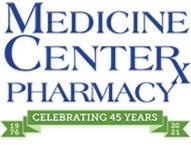Hospital stays can be full of surprises; one might be that the doctor who shows up in place of your personal physician. Hospitalist medicine is the fastest-growing medical specialty in the United States. Demand for this specialty was initially fueled by managed care efforts to bolster efficiency, cut costs, and improve care. Today, patients admitted to the hospital tend to be more severely ill. Hospital-based doctors can better attend such patients, respond to their problems and navigate the hospital’s increasingly complex systems.
Today we're going to talk with Dr. Michael Linz and we're going to talk about what a hospitalist is and how during a time, when a patient might feel vulnerable, they are there to manage their care and work with their personal physician.
We'd like to remind our listeners today that our program's also available on our podcast. You can just look for Health Matters with the Medicine Center Pharmacy in your favorite podcast app, and listen to any of our programs anytime. You can also post up questions on our live Facebook feed today. [00:42]
What is a Hospitalist?
Quiz Time! Choose your answer from the possible answers below:
A groupie of the TV show “House”, who's obsessed with the smell of hospitals, and hangs out in the waiting room all day, talking with the ladies at the information desk, drinking day-old coffee, and eating packages of stale Graham crackers.
The real application of Bill Murray in Groundhog Day, waking up every morning and perpetual training in the residency program, being on call 24/7, no patient cap and no duty restriction hours.
Your third choice is, not actually a physician at all, but an undercover administrator hired by the hospitalist to control utilization management, kind of like Undercover Boss that infiltrates the medical staff and reports all rumors back to the CEO.
The last potential answer is the main cog in the fastest-growing specialty in American medical history, boasting more than 50,000 physicians in a mere 20-plus years, transforming itself, not only into an indispensable part of the hospitalist patient's care and management team, but the key driver in future health systems delivery and payment reform. [01:56]
The answer is D.
History of Hospitalist Concept
Interestingly, this is a concept that started in California in the early 1990s. It was first brought into play by the Scripps Clinic in La Jolla, but it really first became its own entity in 1996, where Paul Wachter, who is known as the father of hospitalist medicine, coined the term “hospitalist” in the New England journal article in 1996. So, it actually started in earnest and the University of San Francisco, California. So, it's only been around for 20-plus years. [03:20]
Can Smaller Hospitals Do This?
Hospitalist programs can be anywhere from 30 or 40 docs up to three, four or five physicians. A union hospital in Dover, which is a relatively small hospital and an access hospital has hospitalist program. They have programs out in Coshocton and in some of the critical access hospitals, much smaller in size than sometimes you may have just one hospitalist working as an admissions position for the day, but it can be anywhere from one to a hundred. [05:32]
What are the Pros of Hospitalist Medicine?
Well, that's the premise; it's easier said than done. The advantage of the hospitalist model is you have physicians that are hospital-based, 24 hours a day, seven days a week. So, you have immediate access to care at the bedside. You have efficiencies in moving through testing procedures, working with consultants. You have protocols that are in place for managing length of stay, and efficiencies of transfers of care. And so you have somebody who is there, basically, at all hours of the day, and we really work as an extension of the primary care physician as far as communication and interaction with them as well. [07:03]
Availability of physicians 24/7
Mercy not only has a hospitalist program, which is medicine and whatnot, they also have an OBGYN hospitalist program as well. So, OB-hospitalists that, again, are there 24/7 and help with the deliveries and whatnot. There are hospitalists in pediatrics, neurology, and also in the post-transitional care in the nursing facilities as well. So it's really a continuum of care that's being developed and integrated. [08:27]
What if you want to see your own doctor instead of a hospitalist?
Normally, your primary care physician notifies their patient population that they don't go to the hospital regularly, and that they're being cared for by hospitalists. So, we have an understood relationship with which physicians that we take care of their patients or not. And so I've really never had anybody say, “I don't want you to take care of me”. I've had instances where we'll get the primary care physician, maybe on the phone, and we have a three-way conversation. But, generally, it's been a smooth process, and I think the population understands the changes in healthcare and how medicine works. [09:15]
How do we become a Hospitalist?
The majority of the hospitalists, probably 90% of hospitalists, are graduates of an internal medicine residency program, which is a hospital-based program. So, you have to have a residency graduate training, just like you would in any other primary care specialty.
There's a growing number of programs that are actually having different tracks where you can go into the training program and move as an inpatient track, really moving as a hospitalist or an outpatient track where you're going to work in the outpatient setting. Family medicine, which traditionally has always been an outpatient practice, now also has an inpatient track as well, and I have to my physicians or family medicine grads, who did an intensive inpatient program, and so it is definitely stratifying to its own drummer. And I think eventually there will be specifically categorized programs in hospitals medicine as more of the teaching programs are overseen by academic hospitalists. [10:37]
What are the work models for a Hospitalist?
There are various work models for the hospitalist system. The most common or traditional is what's called a “seven-on seven-off model” where a physician will work seven days in a row and then have seven days off. The shifts are usually 12 hours, seven in the morning till seven in the evening, and then seven in the evening till seven in the morning, depending on what your work shift is. Other models are a “Monday through Friday model” where a physician will work Monday through Friday at various times, and then weekends are done on a rotational basis.
The seven-on seven-off model has various mutations as well, where people work part of a week, especially if they're part-time, or they have families at home and they want to work just X amount of shifts per month, there are swing shifts that come in throughout the day. So, there are all these machinations off this model, but that's the traditional model that works. [15:24]
What type of patients do you care for?
Our hospital is a team that cares for all patients that come through the door that have medical issues. So, we take care of patients who are co-managed with the intensivist and the ICU, with the cardiologists in the CCU, with cardiovascular surgeons. We admit all the normal traditional health issues to the hospital: pneumonia, congestive heart failure, infections, abdominal pain. We also work on a consultant role for the trauma program. So, a patient comes in with trauma we’ll handle their medical issues, or we'll do consultant work for orthopedic care or rehab care.
So, we really run the entire spectrum. And again, there are specialized physicians within their same disciplines. So, in internal medicine, we don't see young children, and we don't do any OB. So, the obstetricians have OB hospitalist, the pediatricians have a pediatric hospitalist. So, it's divided based on training. [17:49]
Tell us about Sound Physicians
Sound Physicians, it’s a very cool story. It was founded in 2001 by a physician by the name of Rob Bessler, who's from Ohio, grew up in Berea, did his medical education at Case Western and his residency at Cleveland Clinic. He ended up on the West Coast in Tacoma, Washington, and with eight or nine other guys started a hospitalist program was one hospital in Tacoma with nine doctors in 2001. So, fast forward, 19 years, and Sound Physicians is the largest hospital management group in the country. They are 42 states, 3,500 providers, over 350 hospitals, and all physician-run, physician-led, physician-managed, which is very comforting to myself knowing that I have a physician at the top of the chain who is making decisions based on safety and quality of health care. [20:52]
What other advantages are there of the hospitalist model?
Well, there are a number of advantages:
The data is pretty strong as it reduces the cost of care, predominantly, by being able to reduce length of stay, improve efficiencies, have testing done in a timely manner, getting results back, co-managing with the consultants, discussing with them, working at the bedside with the patient and families, working with the case management department, and moving people through in a timely manner; not rushing people through their hospital stay, but working efficiently.
The other important thing is, even though it decreases the length of stay, it does not affect; we never allow patient safety and quality of care to be superseded by time. So, that's very important.
The other advantage is quality of care and patient satisfaction scores are higher in the hospitalist medicine model. Again, because you're there, you can go back and see the patient two or three times a day, meet with the family, discuss things, meet with the consultant. So, it's the ability to have one on one open communication that is really, really a key.
So, our model allows us time at the bedside rather than having us have to go into the computer and have our head buried in a laptop. We actually sit down at the bedside and talk to the patients and comfort them, and actually provide them the time that they require. [25:27]














Aultman’s Comprehensive Medical Rehabilitation Program is a 60-bed intensive
inpatient rehab unit. Their specially trained and skilled staff will assist you as you
recover from your injury or illness. From Physicians and nurses to dietitians and
social workers the focus is to restore function and improve the overall quality of
life after the illness or injury.